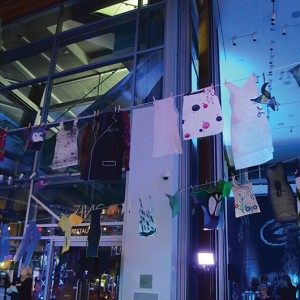Museum of Human Rights
Worth a trip to Winnipeg to visit and explore.

When I was a young single mother I drove my car everywhere with the girls to visit. Now, one of my daughters works for an airline, so I can fly almost free, and I take advantage of that. In January, I flew to Winnipeg for one day and two nights, and we visited the new Museum of Human Rights. I left Edmonton late one day, spent the next day at the Museum, and flew back the following day. It was a short trip, but really worth it to experience this unique museum.
The Museum of Human Rights has a curvy, free-form outside, and eight floors inside. From the outside, it looks like a huge blanket wrapped around a person. Each floor has a different exhibit, and various technologies are used to gather feedback from the public. There is an elevator in the centre of the building to take you up to the central tower. There are also walking ramps which offer a chance to reflect and walk slowly or fast, through various environments. They can be tunnel-like structures, or open ramps where light floods in. The building materials are concrete, wood, and metal and these are used in a number of unique ways, along with various textures.
The museum’s eight floors explore and explain concepts of human rights through the ages, with special reference to Canada, “in order to enhance the public’s understanding of human rights, to promote respect for others, and to encourage reflection and dialogue.” Complex issues are explored from multiple perspectives using personal stories from diverse groups, which provide powerful lessons.
I knew about a number of the events that violated human rights, but had never put them all together in one place. Level One has the necessary check-in counters, coat rooms, plus a garden of rocks and a pond for reflection. Level Two outlines the history of the world, which is a staggering sight as you wander and read the wall of events in which various group’s human rights were violated. Events such as slavery, child labour, wars, famine, and discrimination on the basis of race, age, religion, gender, country of birth, and being refugees. The right to vote for women and Aboriginal people is also explored for Canada. I came away shaking my head – “Why do we do this to one another? We need to learn to respect all people.”
Level Three examines movements that protected human rights in Canada. Level Four examines the Holocaust, secrecy, and turning points for humanity like the Universal Declaration of Human Rights. Level Five explores our human rights today, and Level Six has changing exhibits, the first of which explored the result of residential schools on our Aboriginal population. In this exhibit, artists travelled with the Truth and Reconciliation Commission, and gathered artifacts from each of the residential schools. They then wove these into a wooden “quilt” of things that served as symbols of abuse: door knobs, wash basins, cooking pots, photos, posters, signs, etc.
Level Seven explores how to inspire change, and gives each visitor a chance to say what they will do to change attitudes. Level Eight is a tower of glass, from which you can look down on the world with new ideas for respect and appreciation for all people.
This museum is well worth the trip. It is very thought-provoking and moving. It gives us a chance to make changes in our own attitudes. When in Winnipeg, make sure to spend at least a half day there.





